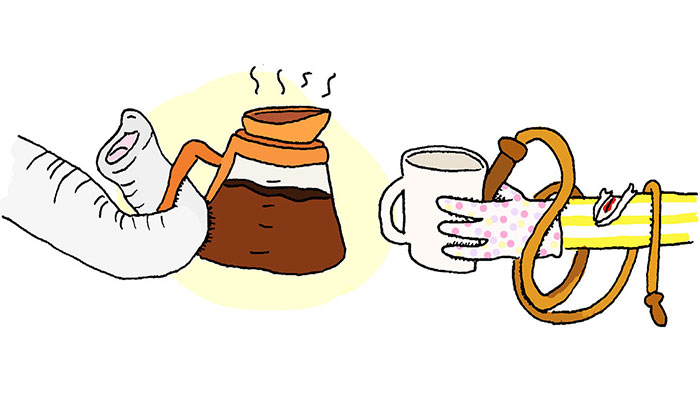A cold, wet wind blasts dismissal slips past my face as I stare at the benignly dominant sign outside the Canadian Corporate Embassy in Dublin—titanic in scale and, perhaps, hubris.
Carved from giant Quebec maples and framed with Ontario nickel, its lights powered by Alberta bitumen, the sign is clearly the work of a confident nation. Its message is concise, if cryptic:
SUGAR IS FREEDOM
CAFFEINE IS PEACE
COME TO CANADA
SHAPE ITS DESTINY
ROLL UP THE RIM
Since my layoff five months ago as a Training Transition and Adaptation Counsellor for former employees of the Ireland Quasi-Autonomous Non-governmental Anti–Money Laundering Organization’s Pension Fund, I have grown desperate. Canada needs me, and I need Canada.
Inside the embassy, I am registered for the Evanescent Foreign Factotum Program, given a small batch of sugared dough, and told that I am now a para-Canadian.
Suddenly, I am across the ocean and on a train, the Flatlander (its windows blacked out to protect us from the “blinding Canadian snow”), along with 1,984 other recent hires of Tim Hortons Shoqeri me Pergjegjesi te Kufizuar, an Albanian shell company and Canada’s largest employer, food supplier, user of hot water, litigator, source of sales tax revenue, and mythmaker.
We are headed for the world’s most advanced foodstuffs fulfillment centre, located in a free trade zone that straddles the Ontario–Manitoba border, its precise latitude and longitude a state secret. Just days ago, I was under the impression that Tim Hortons simply sold cups of hot coffee. Now I am not so sure.
The Flatlander pulls in to a building so huge that it has its own postal code, microclimate, and gravitational force. This is the Fritterplex, the high-tech mega-facility where all of Tim’s coffee and “food service impulse consumables” are made. All of it.
It is also where new workers are trained: thousands of them, as if in some sort of polyester brown Super Mario refugee camp, dispense pre-measured cream and sugar, toast bagels, and line up for hours to test the new Customer Viscosity Improvement Strategies.
At one end of the cavernous room, a fifty-year-old black and white poster, far too large for indoor display, is tacked to the wall. It depicts the frighteningly charming face of a man, about forty with a crewcut, extensive facial bruising, many stitches, and missing teeth, but ruggedly handsome features. A picture so contrived that its eyes follow you about when you move. WE NEED TO GET MORE TRAFFIC IN FRONT OF THE NET, the caption beneath it reads.
Under its watchful gaze, in our new ill-fitting uniforms, complete with name tags that indicate our level of competence and country of origin, we are herded into smaller groups for five days of intensive training. We will sleep here (the only time, we are told, that it is permissible to sleep on Tim Hortons premises), eat here (sampling every item on the menu, in descending order of nutritional value), and “become Canadian” here (in the non–legally binding, small-talk sense).
Day 1: We watch the volcano-sized vats of brewing coffee, the satanic honey dip donut mills, and the pipeline and pneumatic tube systems that deliver everything to thousands of Tim’s stores worldwide. A guy with a clipboard tells us that annual shipments of double-doubles exceed those of crude oil in volume.
I have met some of the other trainees, and I now realize that the cream of Pakistan’s rocket science industry, of Filipino poetry, and of Cambodian neuroscience are alongside me, learning to pour twenty-one-minute-old java down the drain.
Day 2: We practise the choreography of serving Biped Profit Centres (customers), using a scientific formula that can shave milliseconds off the ordering process: 2 seconds of eye contact + 3 seconds of upselling + 1 second of lighthearted meta-banter in a mid-Saskatchewan accent = secret sauce of Tim’s sales efficiency.
Day 3: There are so many variations on orders and sizes! We must learn all of them by rote: the Four-by-Four, the Dairy Farm, the Puck Drop, the Defibrillator, the Nebuchadnezzar, and so on. We are told to forget normal distinctions of day and night, and conform instead to Tim’s own division of the twenty-four-hour clock, parsed into such segments as the Pre-breakfast Fast Break, the Truants’ Early Lunch, the Circadian Droop Hour, the Getting Out of the House Precious Moment, and the Free Wi-Fi Beverage Consumption Period. Each draws its own kind of customer, whose lack of self-awareness is key to our profitability. Did I just say “our” ?
Day 4: To better understand the “consumption priorities” of the End-of-Supply-Chain Targets, we attend a PowerPoint presentation. Responses gleaned from millions of comment forms cover everything from phobias about spilled coffee to how many free napkins is too many to take; from whether steeped tea is “gay,” to the relative fulfillment one feels after one, two, or sixteen Timbits. This invaluable data set recently replaced the Census of Canada as the most authoritative, scholarly source of information about the citizenry.
Day 5: It had not occurred to me back in Ireland that someone, somewhere is thinking about the future of donuts twenty-four hours a day. But I can assure you that these experts exist, in the We’ll Be Right with You Lab, where, after we leave a returnable blood sample, we are shown products in development. They include a baked ball of sugar cane the size of a human head (tremendous savings on processing costs), and pure caffeine in liquid form (Coffeen™). In the coming months, the lab is looking to train psychics who can foresee customers’ orders in store or even remotely.
Ultimately, I anticipate that most of us will be laid off, what with plans for on-site 3-D printing of donuts, and the ultimate meta-product: something to satisfy the desire beneath the desire for coffee—but without having to make coffee. My training is complete, and I start work next week! Not at an actual Tim Hortons outpost, mind you. It’s a fake one set up at a former hospital in the Sultanate of Oman, for a photo op with the prime minister. Canada will be sending 500 Tim’s workers there as a goodwill/revenue-seeding gesture. They say if I do a good job, I could possibly transfer to the Beef Lasagna Casserole pits before long!
This appeared in the May 2014 issue.






